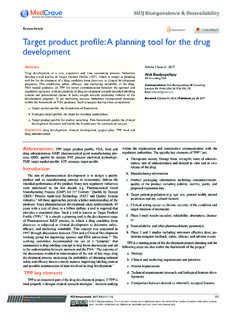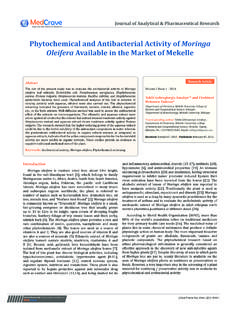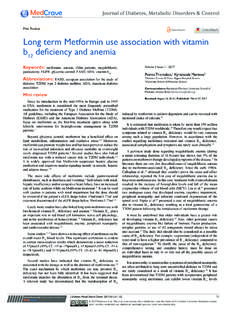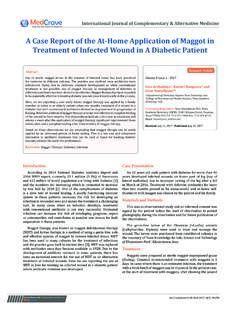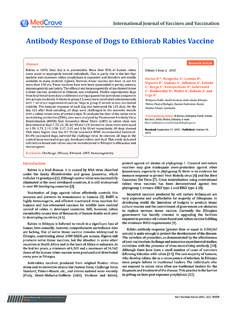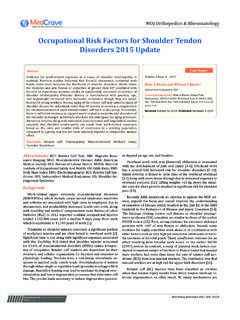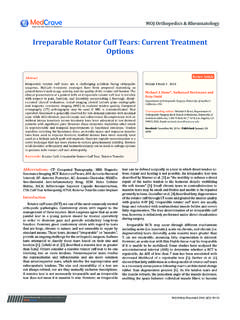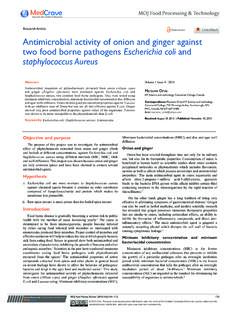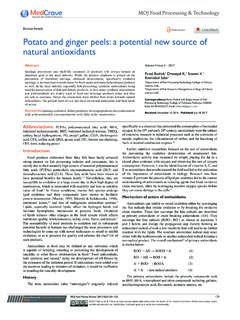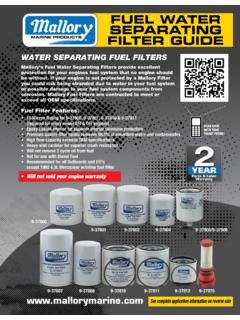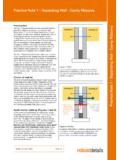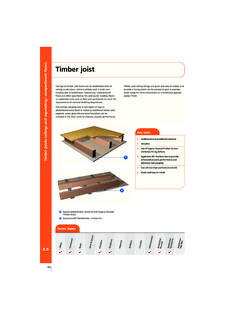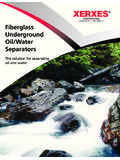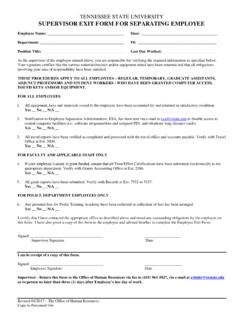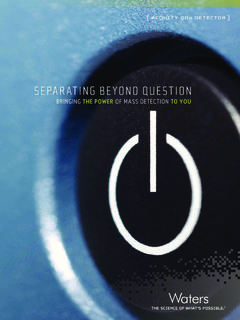Transcription of Advancement of oil/water separating materials: …
1 Submit Manuscript | the last few years, there are hundreds of large oil spill incidents throughout the world, among them Montara oil spill (Australia), Deep water horizon (Gulf of Mexico), Xingang Port oil spill are the most alarming. In India also Mumbai oil spillage 2010 and Chennai oil spillage 2017 leave severe environmental consequences. Oil spillage is one of the most serious environmental and ecological ,2 Oil contamination from various industries is also causing considerable amount of water pollution. The marine atmosphere and sea water are the most affected due to these incidents, so there is an urgent need of development of material for collection and separation of oil and oily organic pollutant from water sources. The techniques which are being used to clean up such leakage or spillage are mainly skimming, addition of chemical dispersant, use of filtrating medium and various sorbents.
2 Skimming is the most common method for this purpose, but it is very time consuming, costly and inefficient. Second most widely used method is use of oil dispersant, which separates oil into droplets, but this method adds additional toxic chemical into sea and requires additional separating ,4 Use of filtrating materials and sorbents are the most effective and convenient way to the clean and recollects oil from oil ,6 In the last five years, there is an exponential growth in the research related to materials for oil- water separation. Purposefully constructed and specially designed super wetting surface are found to be helpful for selectively separating oil and water . In particular, special wettable materials with distinct opposite affinities towards oil or water are believed to be the most promising materials for selective oil/water 9 The subject to be covered in the following sections are various separation techniques, materials and scientific basis of , two kinds of special wettable materials are suitable for oil/water separation, , hydrophobic-oleophilic materials, and hydrophilic-oleophobic materials.
3 Superhydrophobic-superoleophilic materials are actually oil removing materials from the bulk. This particular type of wetting property of material will repel the water phase and absorb oil, thus separating oils from an oil and water mixture. Superhydrophilic-superoleophobic materials are water removing material from the oil- water mixture with the reverse selectivity to the oil absorbing materials. Various metallic mesh material , fabric material , carbon based material , powder material , sponge or foam material are reported till date which can be used as oil water separation,10 19 but one major drawback of these fabric and mesh materials is that, they cannot be used directly in the sea, oily water has to be collected and then it has to be filtered.
4 These are difficult to scale-up in large Most effective sorbent reported are the sponge and foam based material because of their easy availability, low cost, very low weight to volume ratio and extremely high porosity they can absorb oil up to hundred times of their weight, but they have less selectivity towards oil or water , they absorb both almost equally. Purposefully constructed and specially designed super wetting surface are found to be helpful for selectively separating oil and water . Drop coating, solution coating, fabrication by electro-spinning, plasma treatment, incorporation of nano particle into sponge material etc. various methodology have been used to prepare such 23 But this methods require toxic chemicals, involve high cost, less scalability in large scale and low reusability.
5 The main emphasis is given into the specialty of the materials, surface wet ability and merits and demerits . Finally, we provide our conclusions and outlook on the future of the work. Separation of layered oil-and- water mixturesFiltration based separation: Depending upon the wettability, modi-fied filtrating materials like metallic meshes, textiles/fabrics, polyme-MOJ Poly Sci. 2017;1(1):11 2017 Jha et al. This is an open access article distributed under the terms of the Creative Commons Attribution License, which permits unrestricted use, distribution, and build upon your work of oil/water separating materials: merits and demerits in real-time applicationsVolume 1 Issue 1 - 2017 Atanu Jha, KSS Sarma, Subhendu Ray Chowdhury Bhabha Atomic Research Centre, IndiaCorrespondence: Subhendu Ray Chowdhury, Isotope and Radiation Application Division, Bhabha Atomic Research Centre, Trombay, Mumbai-400 085, India, Email Received: February 21, 2017 | Published: March 17, 2017 AbstractWith the increase of offshore drilling of oil, production and transportation the chances of oil spillage has enormously increased.
6 Oil spillages have a catastrophic impact on our aquatic environment and ecosystem. In the last few years development of special wettable materials for oil- water separation has received tremendous research and industrial interest. Materials with selective wettability, that is superhydrophobic and superoleophilic, or superhydrophilic and superoleophobic, can be used to remove only one phase from the oil/water mixture. Moreover, the effect of the surface chemistry and surface architecture can further promote the superwetting behaviour and improves separation efficiency. In this review, recently developed materials for oil/water separation are summarized and discussed. These materials have been categorized based on their oil/water separating mechanisms that is filtration or absorption.
7 Representative studies are highlighted, with emphasis on the materials wetting properties that is superhydrophobic/superoleophilic or superoleophobic/superhydrophilic nature, innovative aspects and their applications. The materials with selective wettability can be used for the treatment of oil spills and industrial oily wastewater treatment on an industrial scale. The challenges and future research directions in this emerging and promising research field are briefly described. Keywords: oil- water separation, super wetting property, superhydrophobic, superoleophilicMOJ Polymer Science Mini Review Open AccessAdvancement of oil/water separating materials: merits and demerits in real-time applications12 Copyright: 2017 Jha et : Jha A, Sarma KSS, Chowdhury SR.
8 Advancement of oil/water separating materials: merits and demerits in real-time applications. MOJ Poly Sci. 2017;1(1):11 16. DOI: membranes, allow only one particular phase to pass through. These materials are extensively studied in the last few years for oil- water mesh-based materials: Superhydrophobicity of metallic meshes has been studied over the past few ,24 26 To enhance the selective permeability to water and oil, filtering mesh with su-perhydrophobic and superoleophilic behaviour is prepared, resulting in oil/water separating properties. Feng et has reported the first super-hydrophobic and superoleophilic stainless steel mesh prepa-red via a spray and-dry method in The surface morphology of the mesh is rough and because of its superhydrophobicity and su-peroleophilicity, water droplet stays as a spherical bead on the mesh and oil (diesel) droplet passes through it (Figure 1).
9 In addition to stainless steel mesh, copper mesh is one of the another frequently used substrates for oil/water 33 Wang et reported a superhydrophobic and superoleophilic copper mesh, This as prepared mesh could be used to separate a mixture of oil and water . Similarly, superhydrophilic and superoleophobic meshes can also be used for the same purpose. Preparation of these kinds of material which show both hydrophilicity and oleophobicity is difficult as surface energy of water is higher than Yang et reported a polymer based superhy-drophilic and superoleophobic coating material , prepared from hy-drophilic poly (di-allyl di-methyl ammonium chloride) (PDDA) and oleophobic sodium perfluroocanoate (PFO) and SiO2 nanoparticles.
10 It allows water to spread through the mesh and oil drop keeps minimum contact with the surface and stays as a spherical bead (Figure 2). Kota et al. reported hygro-responsive superhydrophilic and superoleopho-bic membrane material by dip-coating Most of the oil are of less density than water , so a filtrating material with superhydrophili-city and oleophobicity will be more useful and feasible for oil- water separation, if the oil- water mixture is a layered (immiscible) system. Mesh material with underwater superoleophobic superhydrophilic surface can be designed by appropriate surface energy and surface ,37 These materials are also applicable to oil- water separa-tion. Xue et reported polyacrylamide-hydrogel coated mesh with underwater superoleophobicity.
